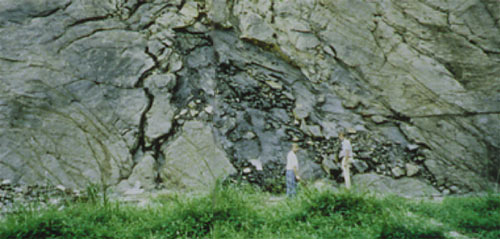Nature at work over the last two billion years

Oklo, traces of a natural reactor
This piece of cliff on the site of the Oklo uranium mines in Gabon contains traces of the operation of a fossil reactor, discovered during the 1970s. Sixteen ‘natural’ reactors were in operation at Oklo for several hundreds of thousands of years, two billion years ago. A conjunction of favourable factors, including its content of fissile uranium-235, which was much higher then than it is now, contributed to this extraordinary phenomenon.
© CEA
It was noticed by chance in the 1970s that a uranium ore deposit in Gabon being mined for its particularly rich uranium content, had functioned as a nuclear reactor two billion years ago. When some Soviet customers complained about an ore delivery with a low uranium-235 content, the quality of deliveries and the honour of the CEA were at stake. Experts were dispatched to the site. They realised that there were major variations in the isotope content in different parts of the deposit. These variations were surprising because isotope content on Earth is generally uniform in an ore.
Because its half-life is six times shorter than that of the more prevalent uranium-238 isotope, the uranium-235 concentration had diminished over time. Two billion years ago, a uranium ore contained approximately 3.5 % of the uranium-235 isotope, i.e. a similar content to that of the enriched fuel of a modern nuclear reactor, so the uranium deposit at Oklo in Gabon could function like a reactor given the right environment. Water played the role of neutron moderator.
There is no comparison between these natural reactors – there had been several on the site – and their man-made counterparts that have been running at full power for decades. At Oklo, the fission reactions occurred slowly over nearly 100,000 years, like a smouldering fire.
The Oklo site offers a unique example of the natural disposal of residues from a reactor core. Detailed analyses show the presence in those seams of a fossil record of radioactive waste that remained where it was and uranium ore with a low uranium-235 content.
It is possible to study the migration of radioactive elements in the subsoil over a very long period, as well as their containment.
The Oklo study has shown that there was little or no uranium migration, and has revealed that minerals in the subsoil effectively trapped certain actinides and fission products. It was found that an environment of phosphates (apatites) was conducive to the retention of the radioelements.
This containment is reassuring, because Nature did not take any precautions. The boiling water produced by the natural reactor would have washed the radioactive material straight out, sometimes causing collapses.
Even in the worst case scenario, it is difficult to imagine this kind of washing out happening at the disposal sites being considered.
Two billion years after these events, the remains of the fossil reactors in Gabon are the subject of arguments that would surprise the primitive beings who were contemporary with them. Some environmentalists in favour of nuclear use them as an example to back up their arguments. Others who are opposed to nuclear are careful to ignore Oklo and never allude to it at all.
Related topic: A race to be slowest
Other articles on the subject « Waste strategies »
Slow disappearances
Trapping radioactivity until it disappears A scenario for the long-term future of the waste It wi[...]
Diluting radioactivity
A practice for elements with low levels of toxicity Management of radioactive waste generally foc[...]
Putting it out of reach
Containment and burial when it is not enough to wait Letting time do its work is not sufficient o[...]
Conditioning
Packages for trapping radioactivity… Conditioning means containing the radioactivity and im[...]
Temporary storages …
Storing: a useful but temporary solution Storing means tidying an object away with the intention [...]
Deep geological disposal
Ground-level and deep disposal: a definitive solution Deep disposal of the most radioactive waste[...]
Separating and sorting
Sorting radioactive waste has advantages As with household waste, sorting can prove really useful[...]
Destroy (transmutation)
Transforming radioactive nuclei to make them less troublesome… The incineration of househol[...]
What to transmute?
Transmuting long-lived actinides and fission products Long-lived elements: actinides and fission [...]
Transmuting actinides
Attractive in principle, difficult in practice Destroying actinides using fission reactions is at[...]